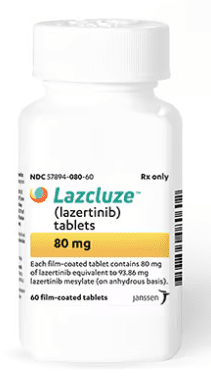Lazcluze Side Effects
Generic name: lazertinib
Medically reviewed by Drugs.com. Last updated on Feb 10, 2025.
Note: This document provides detailed information about Lazcluze.
Applies to lazertinib: oral tablets Side Effects associated with lazertinib. Some dosage forms listed on this page may not apply specifically to the brand name Lazcluze.
Applies to lazertinib: oral tablets.
Side effects include:
Most common adverse reactions (≥20%) of lazertinib (the active ingredient contained in Lazcluze) in combination with amivantamab: rash, nail toxicity, infusion-related reaction (amivantamab), musculoskeletal pain, edema, stomatitis, VTE, paresthesia, fatigue, diarrhea, constipation, COVID-19, hemorrhage, dry skin, decreased appetite, pruritus, nausea, ocular toxicity.
Most common Grade 3 or 4 laboratory abnormalities (≥2%) of lazertinib in combination with amivantamab: decreased albumin, decreased sodium, increased ALT, decreased potassium, decreased hemoglobin, increased AST, increased GGT, increased magnesium.
For healthcare professionals
Applies to lazertinib: oral tablet.
General adverse events
All the reported adverse events are those described in patients who received this drug in combination with amivantamab. The most common adverse events (all grades) were rash, nail toxicity, musculoskeletal pain, edema, stomatitis, venous thromboembolism, paresthesia, fatigue, constipation, COVID-19, hemorrhage, dry skin, decreased appetite, pruritus, nausea, and ocular toxicity.
The most common grade 3 or 4 laboratory abnormalities (2% or greater) were decreased albumin, decreased sodium, increased ALT, decreased potassium, decreased hemoglobin, increased AST, increased GGT, and increased magnesium.[Ref]
Cardiovascular
- Very common (10% or more): Venous thromboembolism (36%)
- Uncommon (0.1% to 1%): Myocardial infarction, cardiopulmonary arrest[Ref]
Dermatologic
- Very common (10% or more): Rash (86%), nail toxicity (71%), dry skin (24%), pruritus (24%)
- Common (1% to 10%): Palmar plantar erythrodysesthesia syndrome, urticaria[Ref]
Gastrointestinal
- Very common (10% or more): Stomatitis (43%), diarrhea (31%), constipation (29%), nausea (21%), vomiting (12%), abdominal pain (11%), hemorrhoids (10%)[Ref]
Hematologic
- Very common (10% or more): Decreased albumin (89%), decreased platelet count (52%), decreased hemoglobin (47%), decreased white blood cells (38%), hemorrhage (25%), decreased neutrophils (15%)[Ref]
Hepatic
- Very common (10% or more): Decreased ALT (65%), decreased AST (52%)
- Frequency not reported: Increased ALT, increased AST, increased GGT[Ref]
Musculoskeletal
- Very common (10% or more): Musculoskeletal pain (47%), muscle spasm (17%)[Ref]
Nervous system
- Very common (10% or more): Paresthesia (35%), dizziness (14%), headache (13%)
- Uncommon (0.1% to 1%): Cerebral infarction[Ref]
Ocular
- Very common (10% or more): Ocular toxicity (16%), conjunctivitis (11%)
- Common (1% to 10%): Keratitis
- Frequency not reported: Growth of eyelashes, visual impairment, other eye disorders[Ref]
Psychiatric
Renal
- Very common (10% or more): Increased creatinine (26%)[Ref]
Respiratory
- Very common (10% or more): Cough (19%), dyspnea (14%)
- Common (1% to 10%): Interstitial lung disease or pneumonitis, pneumonia, respiratory failure
- Uncommon (0.1% to 1%): Pulmonary embolism, acute respiratory distress syndrome[Ref]
Metabolic
- Very common (10% or more): Increased alkaline phosphatase (45%), decreased calcium (41%), decreased gamma-glutamyl transferase (39%), decreased sodium (38%), decreased potassium (30%), decreased magnesium (25%), decreased appetite (24%), increased magnesium (12%)[Ref]
Other
- Very common (10% or more): Edema (43%), fatigue (32%), COVID-19 (26%), pyrexia (12%)
- Common (1% to 10%): Sepsis
- Uncommon (0.1% to 1%): Sudden death[Ref]
See also:
References
1. (2024) "Product Information. Lazcluze (lazertinib)." Janssen Biotech, Inc.
2. (2025) "Product Information. Lazcluze (lazertinib)." Janssen-Cilag Ltd
3. (2025) "Product Information. Lazcluze (lazertinib)." Janssen-Cilag Pty Ltd
More about Lazcluze (lazertinib)
- Check interactions
- Compare alternatives
- Pricing & coupons
- Drug images
- Dosage information
- During pregnancy
- FDA approval history
- Drug class: EGFR inhibitors
- En español
Patient resources
Professional resources
Related treatment guides
Further information
Lazcluze side effects can vary depending on the individual. Always consult your healthcare provider to ensure the information displayed on this page applies to your personal circumstances.
Note: Medication side effects may be underreported. If you are experiencing side effects that are not listed, submit a report to the FDA by following this guide.

